
Angelo Fausto Coppi was an Italian cyclist, the dominant international cyclist of the years after the Second World War. His successes earned him the title Il Campionissimo. He was an all-round racing cyclist: he excelled in both climbing and time trialing, and was also a great sprinter. He won the Giro d'Italia five times, the Tour de France twice, and the World Championship in 1953. Other notable results include winning the Giro di Lombardia five times, the Milan–San Remo three times, as well as wins at Paris–Roubaix and La Flèche Wallonne and setting the hour record (45.798 km) in 1942.
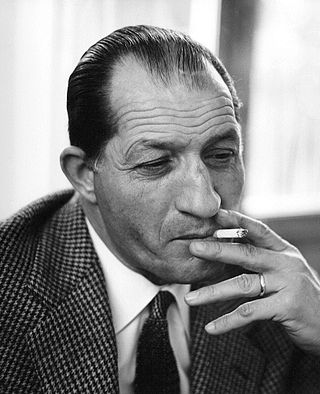
Gino Bartali, nicknamed Gino the Pious and Ginettaccio, was a champion road cyclist. He was the most renowned Italian cyclist before the Second World War, having won the Giro d'Italia twice, in 1936 and 1937, and the Tour de France in 1938. After the war, he added one more victory in each event: the Giro d'Italia in 1946 and the Tour de France in 1948. His second and last Tour de France victory in 1948 gave him the largest gap between victories in the race.

The 1949 Tour de France was the 36th edition of the Tour de France, taking place from 30 June to 24 July. It consisted of 21 stages over 4,808 km (2,988 mi).
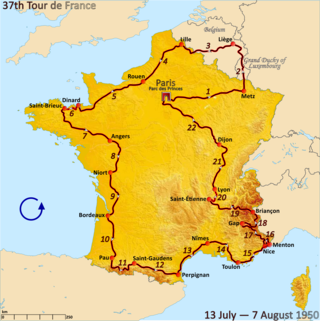
The 1950 Tour de France was the 37th edition of the Tour de France, taking place from 13 July to 7 August. It consisted of 22 stages over 4,773 km (2,966 mi).

The 1948 Tour de France was the 35th edition of the Tour de France, taking place from 30 June to 25 July 1948. It consisted of 21 stages over 4,922 km (3,058 mi).
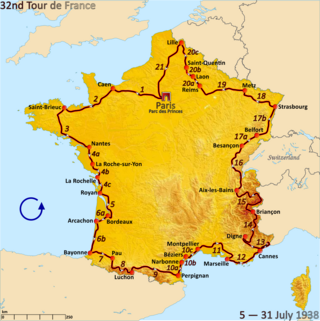
The 1938 Tour de France was the 32nd edition of the Tour de France, taking place from 5 to 31 July. It was composed of 21 stages over 4,694 km (2,917 mi).The race was won by Italian cyclist Gino Bartali, who also won the mountains classification.
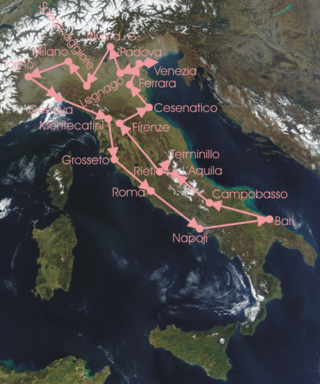
The 1936 Giro d'Italia was the 24th edition of the Giro d'Italia, organized and sponsored by the newspaper La Gazzetta dello Sport. The race began on 16 May in Milan with a stage that stretched 161 km (100 mi) to Turin, finishing back in Milan on 7 June after a 248 km (154 mi) stage and a total distance covered of 3,766 km (2,340 mi). The race was won by Gino Bartali of the Legnano team, with fellow Italians Giuseppe Olmo and Severino Canavesi coming in second and third respectively.
The 1947 Giro d'Italia was the 30th edition of the Giro d'Italia, organized and sponsored by the newspaper La Gazzetta dello Sport. The race began on 24 May in Milan with a stage that stretched 190 km (118 mi) to Turin, finishing back in Milan on 15 June after a 278 km (173 mi) stage and a total distance covered of 3,843 km (2,388 mi).
The Settimana Internazionale di Coppi e Bartali, also known as Coppi e Bartali, is an Italian cycle road race. It is run typically in late March over five days in the Emilia-Romagna region of Italy.
The Gold Medal of Military Valour is an Italian medal established on 21 May 1793 by King Victor Amadeus III of Sardinia for deeds of outstanding gallantry in war by junior officers and soldiers.
The 1946 Giro d'Italia was the 29th edition of the Giro d'Italia, organized and sponsored by the newspaper La Gazzetta dello Sport. The race began on 15 June in Milan with a stage that stretched 185 km (115 mi) to Turin, finishing back in Milan on 7 July after a 176 km (109 mi) stage and a total distance covered of 3,039.5 km (1,889 mi).
The 1940 Giro d'Italia was the 28th edition of the Giro d'Italia, organized and sponsored by the newspaper La Gazzetta dello Sport. The race began on 17 May 1940 in Milan with a stage that stretched 180 km (112 mi) to Turin, finishing back in Milan on 9 June 1940 after a 180 km (112 mi) stage and a total distance covered of 3,574 km (2,221 mi).
The 1939 Giro d'Italia was the 27th edition of the Giro d'Italia, organized and sponsored by the newspaper La Gazzetta dello Sport. The race began on 28 April in Milan with a stage that stretched 182 km (113 mi) to Turin, finishing back in Milan on 18 May after a split stage and a total distance covered of 3,011.4 km (1,871 mi). The race was won by the Italian rider Giovanni Valetti of the Fréjus team, with fellow Italians Gino Bartali and Mario Vicini coming in second and third respectively.
The 1937 Giro d'Italia was the 25th edition of the Giro d'Italia, organized and sponsored by the newspaper La Gazzetta dello Sport. The race began on 8 May in Milan with a stage that stretched 165 km (103 mi) to Turin, finishing back in Milan on 30 May after a split stage and a total distance covered of 3,840 km (2,386 mi). The race was won by Gino Bartali of the Legnano team, with fellow Italians Giovanni Valetti and Enrico Mollo coming in second and third respectively.
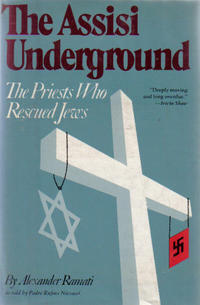
The Assisi Underground: The Priests Who Rescued Jews is a 1978 novel written by Alexander Ramati based on a true-life account, told by Father Rufino Niccacci, of events surrounding the Assisi Network, an effort to hide 300 Jews in the town of Assisi, Italy during World War II.
Alexander Ramati, born David Solomonovich Grinberg, was a Polish writer and film director.
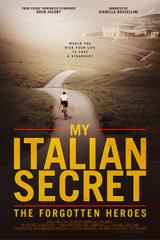
My Italian Secret: The Forgotten Heroes is a 2014 documentary film, directed and written by Oren Jacoby, that tells the story of the rescue of thousands of Italian Jews during World War II by ordinary and prominent Italians, including the champion cyclist Gino Bartali. The film had its U.S. premiere at the Hamptons International Film Festival in October 2014, and opened at theaters in Los Angeles and New York in March 2015.

Legnano was an Italian professional cycling team active from 1906 to 1966. It is ranked as the 6th most successful cycling team in history. Many famous cyclists rode for the team including Alfredo Binda, Learco Guerra, Gino Bartali and Fausto Coppi. The team participated in the Giro d'Italia 46 times, won the team classification 11 times and earned 135 stage wins. It was sponsored by Italian bicycle motorcycle manufacturer Legnano.










